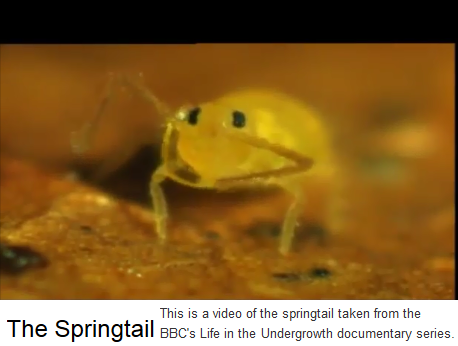Organisms of the soil
It may appear surprising, but there is more life below the soil surface than there is above. In 1 g of soil, there can be more micro-organisms than humans on earth. Now imagine 1 m2 of land. On this tiny area, this is the abundance of the most important soil invertebrate groups in temperate climate regions:
| Flagellates (Protozoans) | 100,000,000 – 10,000,000,000 |
| Roundworms, nematodes (Nematoda) | 1,000,000 – 100,000,000 |
| Mites (Acari) | 70 – 400 |
| Spring tails (Collembola) | 50 – 500 |
| Annelid worms (Enchytraeidae) | 30 – 300 |
| Earthworms (Lumbricidae) | 100 – 500 |
| Snails, slugs (Gastropoda) | 50 - 1,000 |
| Small crustaceans (Isopoda) | 30 – 200 |
| Millipedes (Diplopoda) | 100 – 500 |
| Beetles (Coleoptera), larvae | 100 – 600 |
| Flies (Diptera), larvae | 100 – 1,000 |
Many of these soil creatures are not much bigger than the head of a pin and belong to the so-called micro-flora and fauna with body sizes below 100 µm. The mesofauna (100 µm – 2mm) commonly contains organisms such as mites, springtails and nematodes, and the soil macro- and megafauna (>2 mm) is the diverse size class from spiders and beetles through earthworms to moles.
Although many soil organisms have yet to be identified, our understanding of their role and importance is increasing as we discover how they interact with each other and their surroundings in a complex and interdependent system. Soil organisms can be classified into three main groups which describe the principal function they perform in the soil:
- Chemical engineers
This describes all organisms that decompose organic matter. They are able to break down and transform complex compounds containing carbon and nitrogen into carbon dioxide and the nutrients that plants need.
Members: Bacteria, fungi, algae, viruses, etc. - Biological regulators
This is a rather diverse bunch of organisms which control the work of the chemical engineers. Many fragment and displace organic material, exposing it to microbes and creating more surface area, thus boosting the release of nutrients by the chemical engineers.
Members: Protists, nematodes, springtails, mites, isopods, millipedes, etc. - Ecosystem engineers
They spend their lives restructuring their habitat, mixing and moving soil as they graze, thereby creating habitable spaces and conditions for other soil organisms and plant roots. Their indirect contribution to nutrient cycling plays a key role in improving soil fertility and plant production.
Members: Earthworms, termites, ants, larvae of many insects, mice, moles, etc.
From the above it becomes clear that soil organisms are not just inhabitants of the soil, they ARE PART OF THE SOIL. And as such they heavily influence soil properties such as hydrology, aeration and gaseous composition, all of which are essential for primary production, the decomposition of organic residues and waste materials, and the greenhouse gas balance of the soil.
